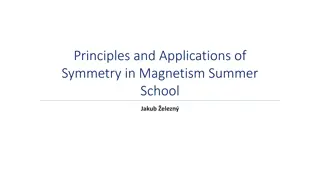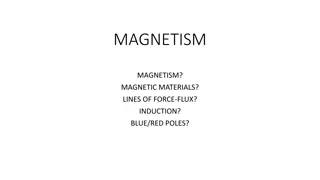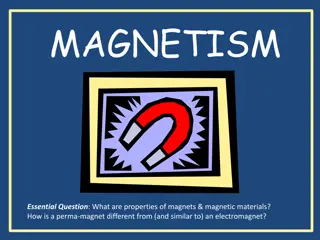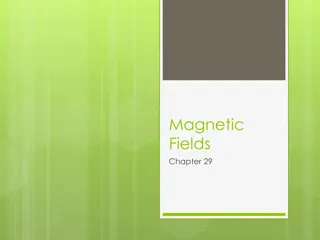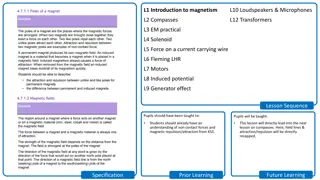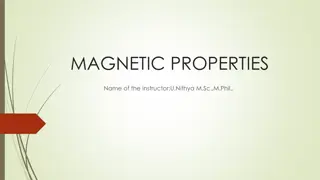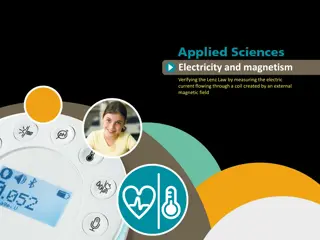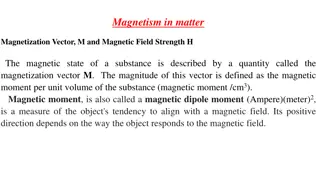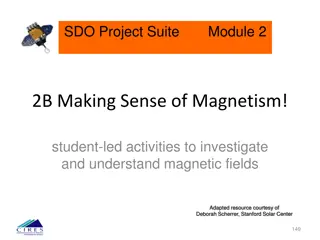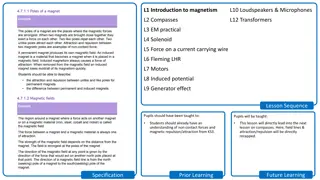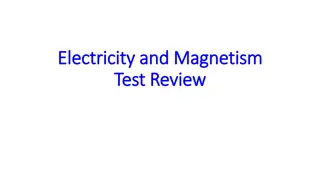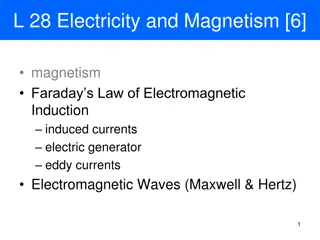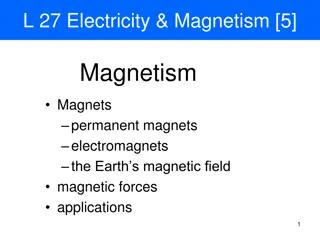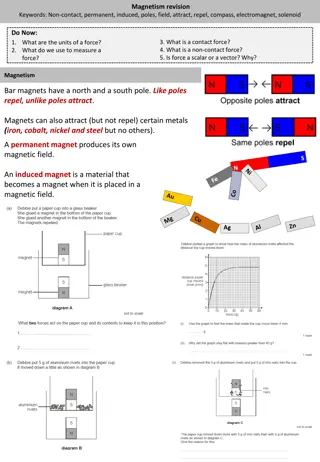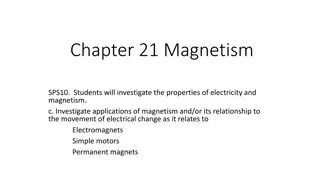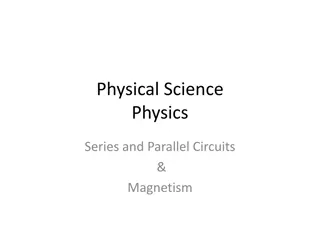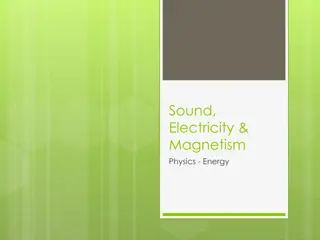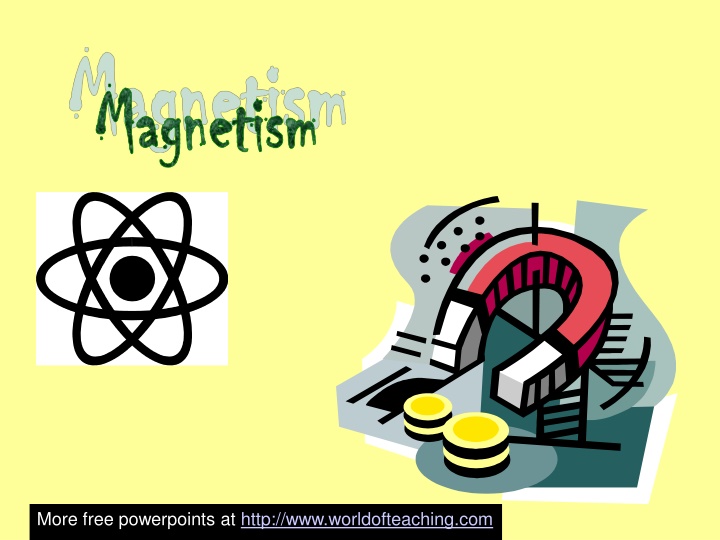
Exploring the Fascinating World of Magnetism
Discover the rich history and scientific principles behind magnetism, from ancient civilizations harnessing its power to modern-day understanding of magnetic phenomena. Learn about magnetic materials, poles, and the captivating forces of attraction and repulsion. Uncover the secrets of magnetism and how it shapes our understanding of the world around us.
Download Presentation

Please find below an Image/Link to download the presentation.
The content on the website is provided AS IS for your information and personal use only. It may not be sold, licensed, or shared on other websites without obtaining consent from the author. If you encounter any issues during the download, it is possible that the publisher has removed the file from their server.
You are allowed to download the files provided on this website for personal or commercial use, subject to the condition that they are used lawfully. All files are the property of their respective owners.
The content on the website is provided AS IS for your information and personal use only. It may not be sold, licensed, or shared on other websites without obtaining consent from the author.
E N D
Presentation Transcript
Magnetism Magnetism More free powerpoints at http://www.worldofteaching.com
Magnets have been known for centuries. The Chinese and Greeks knew about the magical properties of magnets. The ancient Greeks used a stone substance called magnetite. They discovered that the stone always pointed in the same direction. Later, stones of magnetite called lodestones were used in navigation.
William Gilbert, an William Gilbert, an English physician, first English physician, first proposed in 1600 that the proposed in 1600 that the earth itself is a magnet, earth itself is a magnet, and he predicted that the and he predicted that the Earth would be found to Earth would be found to have magnetic poles. have magnetic poles.
What is Magnetism? What is Magnetism? Magnetism is the Magnetism is the force of force of attraction or attraction or repulsion of a repulsion of a magnetic material magnetic material due to the due to the arrangement of its arrangement of its atoms, atoms, particularly its particularly its electrons. electrons.
All magnetic phenomena result from forces between electric charges in motion.
The ends of a magnet are The ends of a magnet are where the magnetic effect is where the magnetic effect is the the strongest. These are called strongest. These are called poles. Each magnet has poles. Each magnet has 2 poles 2 poles 1 north, 1 south. 1 north, 1 south.
Like repels Like repels like like Opposites attract! Opposites attract!
Poles of a magnet always Come in pairs!
If you cut a magnet in half, If you cut a magnet in half, S N S N S N you get 2 magnets! you get 2 magnets!
No Monopoles Allowed It has not been shown to be possible to end up with a single North pole or a single South pole, which is a monopole ("mono" means one or single, thus one pole). S N Note: Some theorists believe that magnetic monopoles may have been made in the early Universe. So far, none have been detected.
Magnetic Fields Magnetic Fields The region where the magnetic forces The region where the magnetic forces act is called the magnetic field act is called the magnetic field
Defining Magnetic Field Direction Magnetic Field vectors as written as B Direction of magnetic field at any point is defined as the direction of motion of a charged particle on which the magnetic field would not exert a force. Magnitude of the B-vector is proportional to the force acting on the moving charge, magnitude of the moving charge, the magnitude of its velocity, and the angle between v and the B-field. Unit is the Tesla or the Gauss (1 T = 10,000 G).
Atoms themselves have magnetic properties due to the spin of the atom s electrons. Groups of atoms join so that their magnetic fields are all going in the same direction These areas of atoms are called domains
When an unmagnetized substance is placed in a magnetic When an unmagnetized substance is placed in a magnetic field, the substance can become magnetized. field, the substance can become magnetized. This happens when the spinning electrons line up in the This happens when the spinning electrons line up in the same direction. same direction.
An unmagnetized substance looks like this
While a magnetized substance looks like this Iron Lodestone (Magnetite)
How to break a magnet: How to break a magnet: 1. Drop it 1. Drop it 2. Heat it 2. Heat it This causes the domains to This causes the domains to become random again! become random again!
Making and Breaking Magnets In most materials, if you add energy to the electrons, you can get them to move and realign Can you think of ways to add energy to electrons? How can you make a magnet? How can you demagnetize a magnet? What happens when you break a magnet?
Magnetic Field Vectors Due to a Bar Magnet N S
N S
N S
N S
N S
N S
N S
N S
N S
N S
Magnetic Field Lines The direction of the magnetic field at any point is tangent to the magnetic field line at that point.
N S
Vocabulary for ELL Magnet: material that can both attract and repel other magnets. Iron is most common. Pole: Part of the magnet where the force is the strongest Metal: material that is often attracted to magnets and a good electrical conductor Horseshoe magnet: U-shaped magnet S N
The Earth is a magnet: The Earth is a magnet: It exerts magnetic forces and is surrounded by a magnetic field that is strongest near the North and South magnetic poles
Sometimes, the Earth s magnetic poles flip. This happens every half- million years or so. Magnetic North Pole Magnetic North Pole Magnetic South Pole Magnetic South Pole
We use the Earths magnetic field to find direction. The needle of a compass always points toward the magnetic south pole. We call this direction North (remember, opposites attract)
Vocabulary for ELL Geographic North pole: the north end of the axis around which the Earth rotates Magnetic North pole: the point on the Earth to which a compass needle points
The sun has a magnetic field, too. It extends far above the sun s surface. Other planets in the solar system also have these magnetic fields
When a charged particle enters a magnetic field, an electric force is exerted on it. If a charged particle moves at an angle to a magnetic field, the magnetic force acting on it will cause it to move in a spiral around the magnetic field lines.
The solar wind is constantly bombarding the Earth s magnetic field. Sometimes these charged particles penetrate that field. These particles are found in two large regions known as the Van Allen Belts.
T he E arths magnetic field extends far into space. It is called the magnetosphere. T he E arth s magnetic field extends far into space. It is called the magnetosphere. W hen the magnetic particles from the sun, called solar wind , strike this magnetosphere, we see a phenomenon called W hen the magnetic particles from the sun, called solar wind , strike this magnetosphere, we see a phenomenon called
The Aurora Borealis in the Northern Hemisphere And the Aurora Australis in the Southern Hemisphere
Electricity and Magnetism Electric forces hold atoms and molecules together. Electricity controls our thinking, feeling, muscles and metabolic processes. Electricity and magnetism underpin much of our current technology (e.g. computers). Electricity and magnetism are linked on a fundamental level.
Electric Motor An electric motor, is a machine which converts electrical energy into mechanical (rotational or kinetic) energy. A current is passed through a loop which is immersed in a magnetic field. A force exists on the top leg of the loop which pulls the loop out of the paper, while a force on the bottom leg of the loop pushes the loop into the paper. The net effect of these forces is to rotate the loop.

